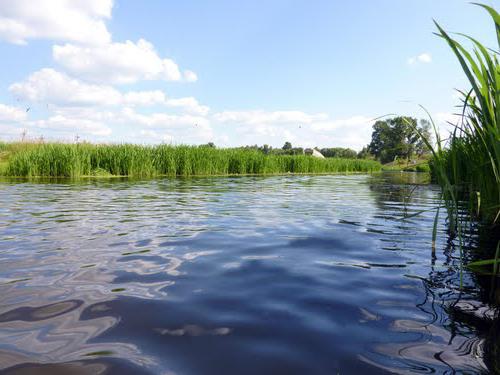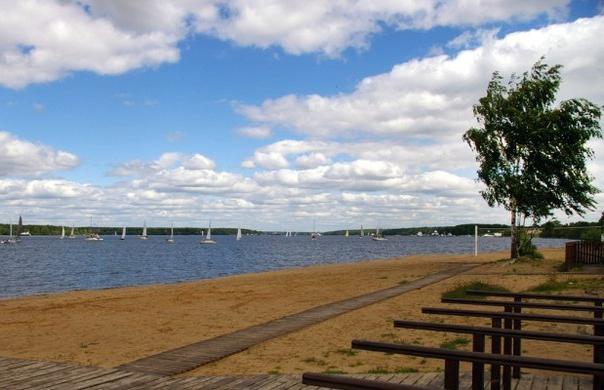Klyazma is a river located in Russia, in the European part of the country. It flows through the territory of the Nizhny Novgorod, Ivanovo, Vladimir and Moscow regions. It is the left tributary of the Oka. The article will discuss this glorious river.
Main characteristics
Klyazma is a river with a length of 686 kilometers and a basin area of 42.5 kilometers. The average annual consumption of water resources is 139-147 m 3 / s (185 kilometers from the mouth, in the vicinity of the city of Kovrov). The food of the river is mostly snowy. Klyazma freezes in November; it is opened in the first half of April. There are many cities on the river: Schelkovo, Dolgoprudny, Korolev, Noginsk, Losino-Petrovsky, Pavlovsky Posad, Gorokhovets, Vyazniki, Kovrov, Vladimir, Sobinka, Orekhovo-Zuevo. The coast of Klyazma is inhabited by approximately 1.7 million people. More than 3.3 million people live in the river basin zone.
Geographical Description
Within the Moscow Upland, the Klyazma River originates. The map shows that its source is located near the city of Solnechnogorsk. Then the river flows in a southeast direction, along the territory of Moscow (Khimki urban district). Her path continues along the border of the Molzhaninovsky district of the capital, near the village of Cherkizova turns east. The riverbanks in the upper reaches are high, the valley is quite narrow. At the Klyazma reservoir, the width is 12 meters. The river flows through the Pirogovskoe and Klyazma reservoirs, where it mixes with the Volga. Downstream, the flow is regulated, the width near the Klyazma railway platform is 20 meters. The water stream runs along the Meshchera lowland, in this place the right bank is much lower than the left. Klyazma is a deep and wide river. In Noginsk its shores are at a distance of 50 meters from each other, in Vladimir - 130 meters. In some places, the width is 200 meters. The depth is shallow, the maximum value is 8 meters, usually 1-2 meters. The bottom of Klyazma is clayey, mostly sandy. In some places, limestone strata cut through the river.

Tributaries
Klyazma is a river with many tributaries. Many of them have ancient Finno-Ugric names and are full-flowing rivers. Inflows are Suvoroshch (14 km), Luh (68 km), Istok (79 km), Tara (110.7 km), Msterka (111 km), Teza (135 km), Shizhzheda (151 km), Nerekhta (190 km ), Sudogda (244 km), Nerl (269 km), Rpen (285 km), Koloksha (326 km), Shalovka (329 km), Vorsha (336 km), Fields (378 km), Peksha (396 km), Birch (416 km), Shchitka (445 km), Kirzhach (459 km), Dubna (466 km), Vyrka (476 km), Drezna (481 km), Vohonka (502 km), Plotnja (514 km), Sherna ( 516 km), Zagrebka (524 km), Chernogolovka (526 km), Lavrovka (526 km), Shalovka (540 km), Vorya (551 km), Ucha (577 km), Alba (640 km), Radomlya (665 km) ), Chernavka (671).
Ancient settlements
The Klyazma River, photos of which are published in this article, has been a place of settlement of different peoples since ancient times. Archaeological excavations indicate that on its shores lived the people of the Paleolithic era (Sungir), Neolithic (parking in the Yoginsky district near the village of Bunkova), the Mesolithic (Pavlovsky Posad district, the vicinity of the village of Saurovo). Later on the Klyazma lived tribes Meria, Murom, Meshchera. Many tributaries of the river are named in the language of these ancient tribes. Slavic burial mounds first in these parts were also found on the banks.
Using
Klyazma is a river with which the development of the entire north-eastern part of Russia is connected, starting from the 12th century, from the period of the Vladimir-Suzdal principality. In those days, the river was navigable along its entire length. Even before the Slavic settlement, the Klyazma-Skhodnya-Moscow trade route provided for the economic development of the region. With the advent of various crafts in the 17th century, many ceramic, textile and paper industries appeared on the river, first handicraft, and then factory and factory.
In the 20th century, in 1937, the construction of the canal was completed. Moscow, in the upper river was blocked by the Pirogov dam, and the Klyazma reservoir was formed. Water flow through dams became regulated and began to be fed by the Volga and rivers of the northern part of the Moscow region. In 1941, two hydroelectric power stations began to be erected on Klyazma, however, with the outbreak of war, their construction was stopped. In the last century, in the 70s, a construction project was presented for consideration on the outskirts of the capital of the Eastern Shipping Canal.
At present, the river in its lower and middle reaches provides water for various industries and residents of numerous settlements. Klyazma is navigable at a distance of 267 kilometers, from its mouth to the city of Vladimir, it is used for the transport of goods by barges. In the middle reaches, navigation is limited by a rocky bottom and a shallow depth of the section between Mster and Kovrov. There is a cargo port (Vyazniki) on the river and there is an old shipyard in Gorokhovets.
Waterworks
There are many hydraulic structures on the Klyazma River . Several dams were built: in the Solnechnogorsk district (Lunevo village), in the village of Pirogovsky, in the city of Korolev, in the village of Tarasovka, in the villages of Obukhov and Sverdlovsky, in the vicinity of the city of Shchelkovo (village of Amerovo). The concrete dam in Noginsk deserves a separate discussion. Its height is 2.5 meters. It is equipped with a coastal spillway and six adjustable spillways.
On Klyazma there are several water and sewer systems: Orekhovo-Zuevskaya, Pavlovo-Posadskaya, Noginskaya, Obukhovskaya, Shchelkovo. In addition, in the Moscow region there is ongoing hydrological monitoring by the departments of the Moscow Center for Environmental Monitoring and Hydrometeorology. There are three hydrochemical points: in Pavlovsky Posad, Schelkovo and Orekhovo-Zuev.
Fishing
A great place for fishing lovers is the Klyazma River. Fishing in these places is wonderful. Almost all representatives of the river fauna of the central part of the country are found in the waters. The most catching time is spring. It was then that schools of fish began to sail into the river from the reservoir. In the spring, an ide is caught in the wiring, pike and perch are caught in spinning, and the scavenger and roach are caught in float gear and snacks. In summer there is an opportunity to catch asp, common carp, silver bream, crucian carp, carp, tench. Burbot is caught between the bottom driftwood. The rarest and most valuable prey on Klyazma is sterlet.
Horseshoes
A map of the Vladimir region indicates that Klyazma flows through its territory mainly through fields, only occasionally there are dense forests on its way. Soil on the shores in the area consists of sand and clay. There are a lot of steep steep rocks and sandy braids on the river, Klyazma likes to loop and wash in various interesting places. “Horseshoe” is a curious phenomenon that happens when a river suddenly turns around 180 degrees and starts to flow in the opposite direction. Distances between the channels of the same river can reach kilometers. Then two streams gradually connect with each other and form a picturesque island. This is a very beautiful picture. In addition, such places are very rich in different fish. First, an asp is settled in them, then zander and pike take the place. Then, among the washed sand spits with picturesque snags, catfish and burbot begin to come across. Almost all fish appear in water with a clear, not overgrown with bottom vegetation: perch, roach, chub, garter, scavenger, etc. Over time, the horseshoe grows in grass, becomes swampy, but more than a dozen years must pass. In the early years of its existence, such a place is a true paradise for a fishing enthusiast.

Active and passive rest
The Klyazma River (Vladimir Region) is a great place for a pleasant pastime in nature. Due to the strong current you can go kayaking here. The time for such outdoor activities begins in May and ends in September. You can come to Klyazma just to admire its beautiful beaches, overgrown with sedge and willow, reeds, cattail, catches, forest geraniums, a three-part train and other greenery. River waters are adorned with hornwort, Canadian Elodea, egg capsules, water lilies, duckweed, and various types of rdest.
Beach vacation
In the warmer months, you can go to the beach to relax. On the Klyazma river there are a lot of places for recreation. Municipal beaches are regularly cleaned, doctors are on duty and a rescue service is functioning. On the coasts belonging to a rest house, such as the Klyazma boarding house on the reservoir of the same name, catamarans, boats, jet skis and boats are rented. There are sun loungers and umbrellas, cafes and bars. Boat trips on cruise ships decorated in the style of old frigates and other unusual ships are offered. The ecological state of the cool waters of Klyazma is closely watched by experts. Therefore, swimming in the river is not only pleasant, but also safe.